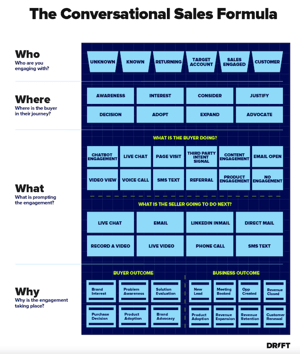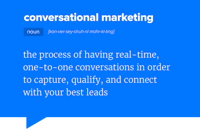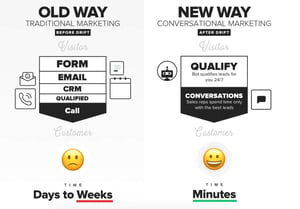Conversational Marketing is a Bigger Topic Than Just Live Chat
Introduction to SignalsFromTheOP
Guide to episode
- Buyer expectations demand more vibrant website interactions
- We prefer to chat with buyers live - why not make it easier for them and us
- There are lots of ways besides live chat to incorporate conversation into our B2B marketing - these include video, voice, chatbots and more
- AI is changing this rapidly and it's allowing companies to manage leads which might otherwise have been ignored by sales reps
Transcript follows
Hi, I’m Ed Marsh. Welcome to this episode of Signals from the OP. My Signals video blogs give me an opportunity to highlight and explore trends and issues which will substantively impact the business of industrial manufacturers – even though they may not be tracking them yet. These are intended to be thought provoking, early warning segments.
Sales, Relationships, Conversations, and Conversational Marketing
Today I want to dive into lead generation and lead follow up from the perspective of conversation.

Rather, I approach this from the perspective of buyer expectations and experience. And there’s a disconnect between what buyers want, and what many industrial companies deliver. That’s not a news flash obviously.
Some will suggest that online chat is a panacea. But when most folks talk about chat, chat bots or conversational marketing the assumption is that we’re talking about lead conversions – taking anonymous visitors to your website and inducing them to provide an email and contact details that you can use to market to them. This is a bigger and broader topic that includes lead follow up, customer service and more.
 Using traditional forms for website visitor lead conversion is an approach that still works, although visitors are increasingly cynical. Visitors and buyers are not as quick to fill them out and submit them as they were 3-5 years ago. So a self-serve, conversational approach which blends bots and live interaction often drives better results.
Using traditional forms for website visitor lead conversion is an approach that still works, although visitors are increasingly cynical. Visitors and buyers are not as quick to fill them out and submit them as they were 3-5 years ago. So a self-serve, conversational approach which blends bots and live interaction often drives better results.
Let’s step back though, because in the background there’s another challenge that’s developed. Industrial sales people are skeptical of web leads. On the one hand sales people always clamor for more of them, on the other they do little to follow up. That’s a broad generalization, and I don’t have reams of data to back it up. I do have lots of anecdotal and client examples, however, which confirm it. I’ve also got a theory.
Many inbound leads are early stage. Some will never be qualified. Many aren’t initially. There’s a lot of thought that goes into funnels and nurturing and how to take early stage leads and cultivate them into qualified sales opportunities.
But there’s a problem inherent in this discussion. We often take a binary approach to leads – they’re either sales qualified, in which case they get personalized follow up – or they’re not, in which case they may get some electronic nurturing. When the follow up is from a person, it’s often very boiler plate, and often abandoned after a step or two.
And when the follow up is via electronic nurturing, most companies don’t dive deeply enough into marketing automation to really create effective, nuanced and rich programs. It’s a lot of work – that means it’s expensive. And for industrial companies that measure their marketing budget in a handful of trade shows and magazine ads that expense is often perceived as extravagant.
So the idea of conversational is often limited, and often breaks down.
Conversational Tools to Help Sales Teams
I believe that’s on the cusp of changing. There’s a variety of technology that’s maturing simultaneously which will enrich conversational marketing, sales and service.
Certainly Drift is a prominent player and incredibly energetic and prolific in building out its product. Simply personalizing chat with the sales or support contact that’s assigned to a contact or account is a huge step. Integrating with marketing automation and CRM tools allows companies to display appropriate messaging for visitors by industry, location, account, quality of lead, existing customer and more.
 Their flexible keyword automation allows you to simulate a simple AI experience for users and enhances the conversational experience.
Their flexible keyword automation allows you to simulate a simple AI experience for users and enhances the conversational experience.
Other tools can compliment this. These are just a couple examples to illustrate the range of options that are available.
Let’s start with simply hyperlinking phone numbers on your website to help mobile users call you. That’s a huge convenience.
Speakpipe allows you to collect voice mails from website visitors, and to require contact details from them in order to submit. In many cases you’ll have cookied them when they visited, and although their APIs are limited, it’s likely feasible to use Zapier to connect this with your marketing automation for segmentation and response.
Several companies like Vidyard & Wistia provide simple Chrome widgets for recording personalized videos for inclusion directly into emails – turning that horribly abused channel of communication into one that’s much more engaging – yet still really simple for reps and service people to use. It can even be coached by leaving a spot in templates for them to add a personalized video.
Followup Edge offers a toolset that allows companies to enroll inbound leads in a customizable workflow which delivers ringless voice mail prerecorded by your assigned sales rep, email and SMS/text messages over 5-7 interactions and several days – increasing connect rates on inbound leads to as high as 42%...without your rep ever getting involved…since they might not be anyway!
VOIQ is rolling out natural voice bots which integrate with marketing automation and have a number of applications. They’re not ready for a dialog yet, but can be configured to speak dynamically generated messages in response to leads, as meeting reminders and more.
And AI is rapidly evolving to enrich the interactions with all these tools.
Put these together and companies have an opportunity to really personalize, conversationalize, and improve the engagement of prospect and customer interaction – and to do it at scale. I like to think of it as multidimensional conversational marketing and sales.
Ease the Customer Journey for Website Visitors
 Each of these vendors shares statistics on how their technology can improve engagement. Drift finds that well designed online chat can double conversion rates. Followup Edge finds that simply by following through in a way that reps often don’t boosts connect rates to 42%, and Vidyard reports that personalized video increases response rates from 3-5X.
Each of these vendors shares statistics on how their technology can improve engagement. Drift finds that well designed online chat can double conversion rates. Followup Edge finds that simply by following through in a way that reps often don’t boosts connect rates to 42%, and Vidyard reports that personalized video increases response rates from 3-5X.
But the bottom line is that integrating these tools into the fabric of your digital footprint, and into the marketing, sales and service practices of your company simply improve the user experience. And that’s an increasingly important objective.
I’m Ed Marsh. Thank you for joining me for this episode of Signals from the OP. If you enjoyed it, please share it and subscribe – either to my youtube channel EdMarshSpeaks.TV or at the related blog SignalsFromTheOP.com.
Expanding the Dialogue: Conversational Marketing as a Catalyst for Business Growth
 In the hybrid manufacturing revenue growth environment that combines digital marketing and sales with the physical and in person, conversational marketing is a pivotal element in transforming how businesses engage with their audience. Digging deeper into conversational marketing, it's crucial to understand how integrating a robust conversational marketing strategy can revitalize sales cycles and foster a conversational growth strategy.
In the hybrid manufacturing revenue growth environment that combines digital marketing and sales with the physical and in person, conversational marketing is a pivotal element in transforming how businesses engage with their audience. Digging deeper into conversational marketing, it's crucial to understand how integrating a robust conversational marketing strategy can revitalize sales cycles and foster a conversational growth strategy.
Conversational Marketing Examples and Growth Strategy
Conversational marketing transcends traditional methods by establishing direct and personalized communication channels. For instance, businesses using chatbots on their pricing pages have witnessed a significant uptick in engagement. These bots, programmed to understand and respond to specific customer queries, guide users through the buyer's journey, offering tailored recommendations based on their responses. This interactive approach not only accelerates the sales cycle but also builds authentic relationships where otherwise visitors would have remained anonymous, enhancing the overall customer experience.
Sales Cycles and Conversational Growth Strategy
The sales cycle, traditionally a linear and often protracted process, is being redefined through conversational marketing. By engaging customers in real-time or asynchronous conversations, businesses can quickly answer questions, reducing the time from initial contact to sale. This acceleration is a cornerstone of the conversational growth strategy, allowing companies to move prospects to meetings and close deals faster and increase revenue.
Role of Digital Marketers in Shaping Conversational Marketing
Digital marketers are pivotal in shaping and executing a conversational marketing strategy, but they need to work closely with sales colleagues. Conversational marketing is fundamentally a user experience and sales enablement play. By leveraging multiple channels such as social media, email, and chat platforms, they can create a seamless communication ecosystem. This approach not only helps in nurturing leads but also ensures that potential customers receive consistent and relevant information across all touchpoints, and keep the assigned rep closely involved with the prospect's activity.
Sales Funnel Transformation
Conversational marketing has revolutionized the traditional sales funnel. By integrating tools such as AI-driven chatbots and personalized messaging, businesses can guide potential customers through each stage of the funnel more efficiently. This strategy helps in identifying and nurturing qualified leads, thereby increasing the likelihood of conversion.
Accelerating Sales Cycles and Meeting Conversational Marketing Goals
The primary goal of conversational marketing is to accelerate sales cycles while establishing and maintaining authentic relationships. By engaging customers in meaningful dialogues, businesses can quickly identify their needs and preferences, allowing for a more targeted and effective sales approach. This method not only shortens the sales cycle but also enhances customer satisfaction.
Inbound Marketing and Conversational Strategies
Inbound marketing, a key component of digital marketing strategies, aligns seamlessly with conversational marketing. By creating content tailored to the buyer personas and their specific stage in the buyer's journey, businesses can attract and engage potential customers more effectively. Conversational tools can then be used to further personalize the interaction, providing a more nuanced and engaging experience.
Harnessing Multiple Channels for Greater Impact
To maximize the impact of conversational marketing, businesses must utilize multiple digital channels. This multi-channel approach ensures that customers can engage with the brand on their preferred platform, be it social media, email, SMS, video, or the company’s website. By being present across various digital channels, businesses can reach a wider audience and cater to diverse preferences.
Building Authentic Relationships Through Personalized Interactions
The essence of conversational marketing lies in its ability to initiate comfortable, natural and authentic relationships with customers. Through personalized and timely interactions, businesses can establish a rapport with their audience, fostering trust and loyalty. This relationship-building is crucial in converting one-time buyers into long-term clients.
The Road Ahead: Embracing the Future of Conversational Marketing
As we look to the future, it's evident that conversational marketing will continue to evolve, becoming an integral part of every business's growth strategy. By understanding and adapting to the nuances of this approach, businesses can not only accelerate their sales cycles but also forge deeper, more meaningful connections with their customers. The journey towards a more interactive and responsive business model is not just about embracing new technologies but about reimagining the very essence of customer engagement in the digital era.


